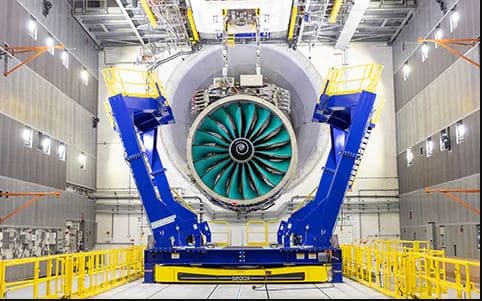Aerospace
Rolls-Royce UltraFan technology demonstrator build complete and getting ready to test
It will be operated using 100% Sustainable Aviation Fuel.

Rolls-Royce announced it has completed building and is preparing to test its UltraFan®, technology demonstrator. In a major milestone for the program, the demonstrator engine was transported from the build workshop and into Testbed 80 in Derby, UK where it was mounted in preparation for testing.
The first test of the demonstrator is expected to take place early next year and will be operated using 100% Sustainable Aviation Fuel.
Rolls-Royce pulls out of Boom’s supersonic jet program(Opens in a new browser tab)
Chris Cholerton, President of Rolls-Royce Civil Aerospace, said: “Seeing the UltraFan demonstrator come together and getting ready for test in Testbed 80 is a great way to end the year. We have all been waiting for this moment, which is such an important milestone for the program and for the team who have worked on it.
The next stage will be to see UltraFan run for the first time on 100% Sustainable Aviation Fuel in 2023, proving the technology is ready to support more sustainable flight in the future.”
Combining a brand new engine design with a suite of technologies to support sustainable air travel for decades to come, the UltraFan demonstrator has a fan diameter of 140 inches and offers a 25% fuel efficiency improvement compared with the first generation of Trent engines.
UltraFan offers a variety of sustainability solutions that will support the journey to net zero aviation. In the nearer term, there are options to transfer technologies from the UltraFan development program to current Trent engines to deliver enhanced fuel efficiency and reductions in emissions.
In the longer term, UltraFan’s scalable technology from ~25,000-110,000lb thrust delivers the potential to further improve the fuel efficiency of both narrowbody and widebody aircraft by up to 10 %.
The UltraFan technology demonstrator program has been supported by the UK’s Aerospace Technology Institute and Innovate UK, the EU’s Clean Sky programs plus LuFo and the State of Brandenburg in Germany.

Aerospace
Boeing Transfers Rocket Stage to NASA, Paving Way for Human Moon Mission

Boeing has achieved a significant milestone by providing NASA with the second core stage of the Space Launch System (SLS) rocket.
This crucial component, crafted at NASA’s Michoud Assembly Facility (MAF), is set to propel the Artemis II crew into lunar orbit, marking humanity’s return to deep space after a 50-year hiatus.
The monumental Boeing-built rocket stage, the largest element of the Artemis II mission, will embark on a journey aboard the Pegasus barge, traveling 900 miles to NASA’s Kennedy Space Center.
Comparison of two legendary aircraft B777x vs B747 aircraft:Click here
Upon arrival, it will be meticulously integrated with other essential Artemis II components, including the upper stage, solid rocket boosters, and NASA’s Orion spacecraft within the iconic Vehicle Assembly Building. This intricate integration process is a vital step toward the eagerly anticipated Artemis II launch, slated for 2025.
“Boeing-built products helped land humankind on the moon in 1969, and we’re proud to continue that legacy through the Artemis generation,” remarked Dave Dutcher, vice president and program manager for Boeing’s SLS program. “Together, with NASA and our industry partners and suppliers, we are building the world’s most capable rocket and paving the way to deep space through America’s rocket factory in New Orleans.”
NASA, Lockheed Martin Reveal X-59 Quiet Supersonic Aircraft:Click here
The delivery of Core Stage 2 marks a significant achievement in the evolution of the SLS rocket. Towering over 200 feet and powered by four RS-25 engines, this core stage, coupled with two solid-fueled booster rockets, will generate a staggering 8.8 million pounds of thrust. This immense power is crucial to launching Artemis II and future missions into the vast expanse of space.
The SLS rocket stands unparalleled in its capability to transport both crew and substantial cargo to the moon and beyond in a single launch. Its extraordinary capacity will facilitate the delivery of human-rated spacecraft, habitats, and scientific missions to destinations including the moon and Mars, ushering in a new era of space exploration.
-

 Travel1 week ago
Travel1 week agoAir India to Expand US Operations with Three New Routes After a Decade
-

 Travel2 weeks ago
Travel2 weeks agoWhy We Should Avoid These Stamps in a Passport
-

 Airlines1 month ago
Airlines1 month agoInvestigations Reveal Fake Chinese Titanium in Boeing and Airbus Jets
-

 Tech4 weeks ago
Tech4 weeks agoChina’s CATL Plans 1,800-Mile Electric Plane Launch by 2027
-

 Airport3 days ago
Airport3 days agoTop 10 Largest Airports in the World by Size
-

 Aerospace4 weeks ago
Aerospace4 weeks agoChina’s Fighter Jets Turn Wings into Autonomous Drones
-

 Airlines4 days ago
Airlines4 days agoAir India Rolls Out A350s for Delhi-New York JFK and Newark Routes
-

 Defence3 weeks ago
Defence3 weeks agoBoeing Enhances Chinook with New Engines and Block II Upgrades at $96 Million







